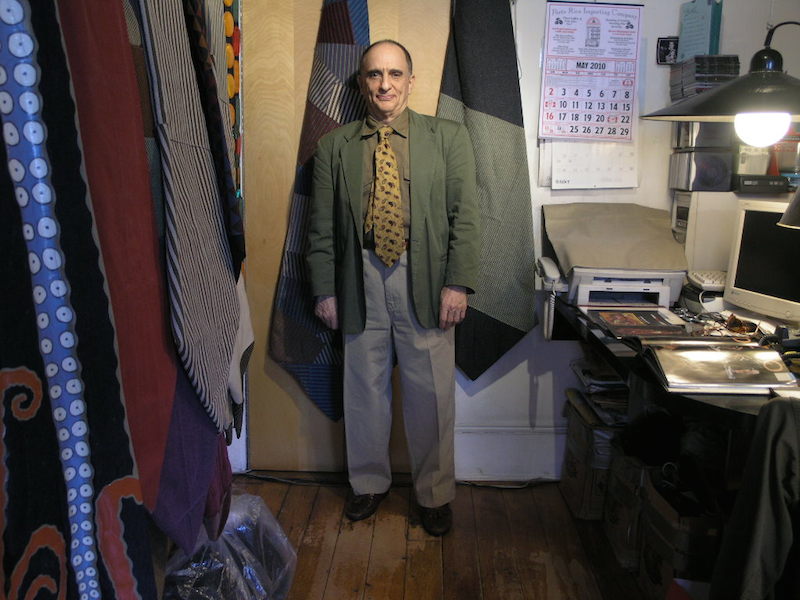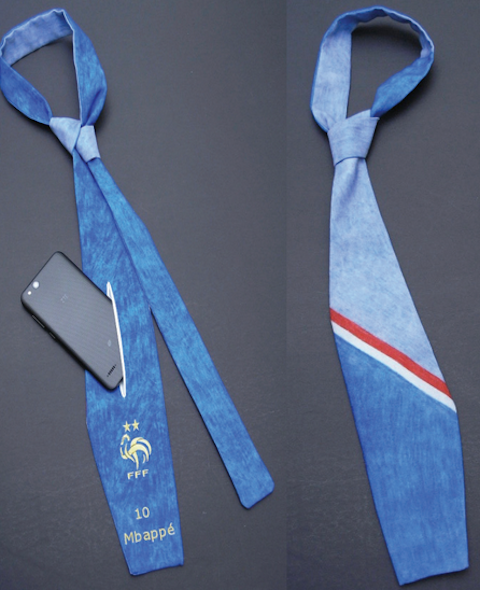Nicholas Daddazio's reinvention of Croatian necktie with a pocket for a cellphone
http://www.croatia.org/crown/articles/11168/1/Nicholas-Daddazios-reinvention-of-Croatian-necktie-with-a-pocket-for-a-cellphone.html
By Nenad N. Bach and Darko ®ubrinić
Published on 06/20/2019

Nicholas B. Daddazio, the Cravat Man in his atelier in New York.
"Thus, the task is not so much to see what no one yet has seen,
but to think what nobody yet has thought about that which everybody sees."
- Arthur Schopenhauer



 | France and Croatia shared a victory celebration together going back to 1648, when Croatia won the Thirty Years' War for France and Louis XIV celebrated with a parade in Paris to honor the Croatian soldiers, who were wearing red cravats, by having Royalty and ordinary Parisians wear similar cravats made by Louis XIV's tailors. France fell in love with the cravat, as well as the other European countries, and thus began the history of the necktie that evolved in design, shape, fabric, and color for more than four hundred years to the present. Daddazio's designs are a re-invention of the necktie with the added feature of a pocket for a cellphone that makes it practical and functional for this new millennium. |
Necktie Sculpture - cravat - as icon and symbol of Western Culture

Nicholas B. Daddazio, the Cravat Man in his atelier in New York.
"Thus, the task is not so much to see what no one yet has seen,
but to think what nobody yet has thought about that which everybody sees."
- Arthur Schopenhauer

Original designs by Daddazio
Tailored exclusively for Les Bleus
Tailored exclusively for Les Bleus

| France and Croatia shared a victory celebration together going back to 1648, when Croatia won the Thirty Years'€™ War for France and Louis XIV celebrated with a parade in Paris to honor the Croatian soldiers, who were wearing red cravats, by having Royalty and ordinary Parisians wear similar cravats made by Louis XIV's tailors. France fell in love with the cravat, as well as the other European countries, and thus began the history of the necktie that evolved in design, shape, fabric, and color for more than four hundred years to the present. Daddazio's designs are a re-invention of the necktie with the added feature of a pocket for a cellphone that makes it practical and functional for this new millennium. |

| Biography / CV of Nicholas B. Daddazio Nicholas Daddazio is a graduate of the University of Buffalo and studied sculpture in New York as an apprentice to legendary sculptor Domenico Facci, working in the Facci Studios for nearly a decade. In 1992, Daddazio opened his own studio at Pietrasanta Fine Arts in Soho, where he continued making figurative sculpture and commenced an intensive study of the necktie as symbol and tribal icon. His study of the necktie resulted in the production of a large collection of bronze necktie sculptures: Reclining Tie; Tie Saxophonist; Tie Ballerina; Tie Geisha; Representational Stripe, Buff, Textured; Tie Trumpet; and many others. In 1994, The Neckwear Association of America commissioned Daddazio to design the trade organization?s new awards trophy, a commission that ran for nearly ten years until the NAA closed its doors. More commissions followed, along with many one-man shows and exhibits and the establishment of the Necktie Sculpture and Art Gallery in 1996 on Cornelia Street in Greenwich Village. In November 2005, Daddazio started making giant necktie sculptures ranging in length from four feet to nine feet in a variety of mixed media: awning canvas, cotton drop cloth, black plastic garbage bags, denim, bubble wrap, orange plastic fencing, orange and blue netting, blue poly tarp, and exquisite furniture fabrics. The artistic expression covers a range from Pop Art to Minimalism to Abstract Expressionism to Realism, and the Nude. The giant neckties can be displayed on walls, in corners, on doors, along a staircase, hung from the ceiling, or flung over a bed, piano, or couch. Daddazio?s sculptures are in the private collections of Ralph Lauren, Tommy Hilfiger, The Versace Estate, Jhane Barnes, Kenneth Cole, the President of Brooks Bros., The Forbes Brothers Private Collection, and many others. Artist Statement of Nicholas B. Daddazio Necktie Sculpture as icon and symbol of Western Culture is an unending subject of interest for me to explore. In 1991, my search for a new and surprisingly unusual, offbeat, out of the ordinary, and unexpected subject for my art led me to the ubiquitous necktie. The necktie was bold, beautiful and everywhere, not as sculpture, though, rather as fashion statement and accessory. The whole world could recognize the necktie in an instant, and in reality it was a Tribal Icon of the West. Forbes even promotes the necktie as a Capitalist Tool! The overwhelming meaning and importance of the necktie remained "submerged" in significance for more than one hundred years in the clutter of our culture. Deep within our mindset was the concept of the necktie as a necessary colorful piece of fabric that brings elegance or meaning to your appearance. The psychological protection expanded over time, beneath the surface of every-day consciousness. The necktie was present, religiously, on the body and not in the form of a bronze sculpture or constructed gigantically in different media and exhibited on a wall. To make the transition, to transform, and to displace the ever-present necktie from its very familiar location so that it is out of "context" and re-born into a form of urban primitive art was a challenge worth pursuing. Exploration began in wax, plaster, wire, and clay models. Of all the models that were made, three emerged which laid the foundation for Necktie Sculpture: Reclining Tie, Tie Ballerina, and Tie Saxophonist. Molds were made for all three pieces which were subsequently cast into bronze using the Lost Wax Method. Many more bronze necktie sculptures followed in the form of representational and figurative pieces, and they were cast in Limited Editions, Open Editions, or unique (one-of-a-kind) sculptures. As output continued in classic bronze, another form of necktie sculpture emerged in November 2005: Mixed Media Necktie Sculpture. The average height of the pieces was six feet, and they were made in bubble wrap, awning canvas, burlap coffee sacks, black garbage bags, blue poly tarp, canvas drop cloth, orange fence, blue and orange netting, fish net, denim, and furniture fabric. The Mixed Media pieces were "sculpted" with objects, constructed, painted on, and hot-glued together. Both classic Bronze Necktie Sculpture and Mixed Media Necktie Sculpture form the basis of my art and a framework for me to continue my study of the necktie as symbol and icon of the West. Source nicholas-b-daddazio.artparks.co.uk Daddazio 31 Cornelia Street New York, N.Y. 10014 212-645-6942 nbdaddazio@mac.com |